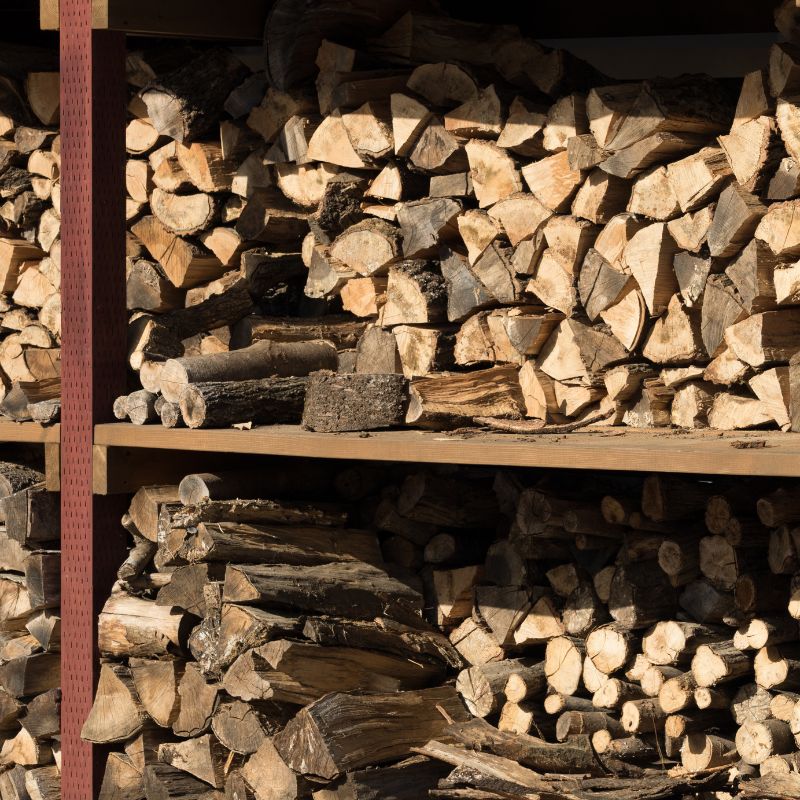If clean, cozy flames are the star of the fireplace show, quality firewood is the indispensable supporting actress. An improperly fueled fire can be challenging to start and maintain at best – and downright dangerous at worst. Good firewood results in efficient, reliable, and all-around pleasing fires in your fireplace or wood stove. While there are a range of options for suitable species of firewood, one thing all good firewood shares is proper seasoning.
We’re here to help you out. Give us a call or book online with us today.
What Is Seasoned Firewood?
To be clear, any wood used in a fireplace or wood stove should be seasoned. The word “seasoned” is applied to firewood that has undergone a drying process to reduce its moisture content.
When newly cut, wood is considered “green” and has a very high moisture content. Reducing the moisture content makes wood suitable for burning, allowing for cleaner combustion, minimal smoke output, and improved heat output. In other words, it’s a crucial factor in ensuring a safer and more efficient fireplace experience.

How To Season Firewood
Firewood can be purchased already air or kiln dried and ready to use. However, you can also season your own firewood, which is a wonderfully economical option for those with access to a ready supply of timber.
Seasoning firewood takes more patience than skill.
- Begin by splitting cut logs into smaller pieces, preferably no longer than six to eight inches across. The goal is to increase the surface area exposed to said, which expedites the drying process.
- Once firewood is split, air does most of the work! Keep in mind, though, that air needs access to the wood to get the job done.
- Keep wood off the ground so it doesn’t absorb any moisture from the ground. And while you do want to shield wood from rain or snow, make sure air can still circulate around the sides.
- Here is where patience comes into play. It usually takes six to twelve months of drying for firewood to achieve optimal seasoning. The exact time will depend on the type of wood and environmental conditions. In the meantime, check your firewood for signs of drying, and rotate the pieces if needed to help it dry evenly.
Why Is Seasoned Wood Important?
Let’s break down some reasons why seasoned firewood is important:
- Efficient burning. Seasoned firewood ignites more readily and burns more efficiently than green or damp wood therefore producing more heat. If moisture content is too high, energy is wasted evaporating water – meaning the fire will not burn as hot, as well, or as long.
- Reduced creosote accumulation. Using exclusively seasoned firewood significantly reduces the buildup of creosote. What’s creosote? It’s a combustible substance that can accumulate in chimney flues. More creosote equals an increased risk of chimney fires and decreased overall chimney well-being. Incomplete combustion due to wet wood contributes to the accumulation of creosote.
- Environmental benefits. Burning seasoned firewood produces fewer emissions, making it a more environmentally friendly option than burning its counterpart, wood with an excessive moisture content. This helps reduce air pollution and also means better air quality in your home.
How To Tell When Firewood Is Seasoned
So seasoned firewood has water content – we get that. But how can we tell when it gets to the right level? There are a number of ways. Some are more precise than others, but all are useful indicators.
- Use a moisture meter. A helpful and relatively inexpensive tool, a moisture meter will give you a quick and precise reading on your logs’ water content – especially if you check a few spots. What is the reading you’re looking for? Firewood can be considered properly seasoned at ten to twenty percent.
- Check for visual clues. Look for visible splits and cracks in the woods, particularly at the ends. As it dries, wood splits. This “checking” indicates that wood is sufficiently dried. Other visual indicators have to do with color. As it seasons, firewood takes on a faded, grayed appearance.
- Listen and weigh. Seasoned wood will feel lighter in weight than green or damp wood due to lost moisture. When struck, it should have a hollow sound.
How To Store Seasoned Wood
You’ve either purchased seasoned wood or taken the time and effort of seasoning it yourself. Either way, you don’t want your resources to go to waste! To keep firewood in ship-shape and ready for use, keep two words in mind: elevation and ventilation.
Elevate your firewood.
Store it off the ground on pallets or a raised platform as a preventative against it contacting any moisture on the ground. Even well-seasoned firewood in contact with moisture will absorb it, and eventually deteriorate, break down, and even mold or mildew. And once the bottom layer is compromised, the problem can work its way up the woodpile. Keeping firewood off the ground will help maintain its quality.

Ventilation is also important.
Ensure adequate airflow around your logs. Exposure to sun and wind is an asset to your firewood, so even while covering the top of your woodpile to protect it from rain and snow, allow the sides of the pile to remain exposed.
How you stack your firewood can also help or hinder ventilation. Don’t stack logs too tightly, but allow air to circulate between logs. Orienting cut ends outward will also promote and maintain drying.
Keep an eye on things.
Check your woodpile periodically, and if you see signs of moisture, make necessary adjustments. Use older wood first, and rotate firewood as needed to make sure wood with higher levels of moisture is given time to dry.
Questions? We’re Here for You
The benefits of fueling your fire well – with seasoned firewood – extend from warmth and enjoyment to safety and efficiency. In short, it’s one key piece in using your fireplace or wood stove for all its worth!
We’re here to help with all of your chimney and fireplace services. Call or reach out online now.
